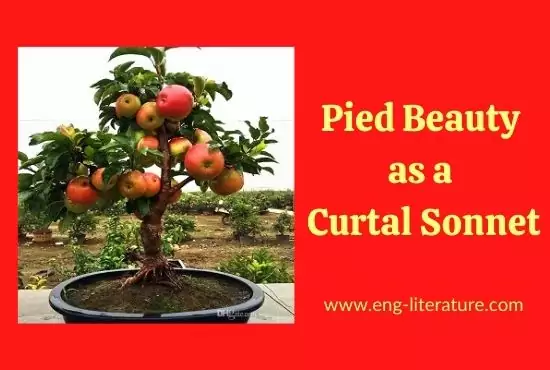Though traditional sonnets are fourteen lines, Gerard Manley Hopkins, in his experiments with poetic form, line, and meter, altered the shape of the sonnet. The curtal sonnet is a form invented by Gerard Manley Hopkins, and used in three of his poems, namely “Pied Beauty”, “Peace” and “Ash Boughs”.
Curtal sonnet is an eleven-line (or, more accurately, ten-and-a-half-line) sonnet, but rather than the first eleven lines of a standard sonnet it consists of precisely ¾ of the structure of a Petrarchan sonnet shrunk proportionally. The octave of a sonnet becomes a sestet and the sestet a quatrain plus an additional “tail piece”- “Praise Him”. That is, the first eight lines of a sonnet are translated into the first six lines of a curtal sonnet and the last six lines of a sonnet are translated into the last four and a half lines of a curtal sonnet. Hopkins describes the last line as half a line, though in fact it can be shorter than half of one of Hopkins’s standard sprung rhythm lines.
Also Read:
The poem celebrates God for the beauty in a varied creation. Hopkins, a devout Jesuit priest, isolates a number of instances of this “pied” or dappled beauty in the first stanza (lines 1-6). He finds it in two-toned skies as well as on cows, on spotted trout, and on the wings of birds. He also sees variety and unity in the contrasts between all these life-forms, for he sees echoes of plants on fish—“rose-moles upon trout,” echoes of the dying embers of fires in the chestnuts falling from the tree. This form allows the simple message of that final line, and Hopkins’s contrast between the world of fickle things and the unalterable world of God, to stand out and be more clearly heard :
‘Praise him.’
Hopkins’s account of the form comes from the preface to his Poems (1876-89). Critics are generally in agreement that the curtal sonnet does not so much constitute a new form as an interpretation of sonnet form as Hopkins believed it to be; as Elisabeth Schneider argues, the curtal sonnet reveals Hopkins’s intense interest in the mathematical proportions of all sonnets.
